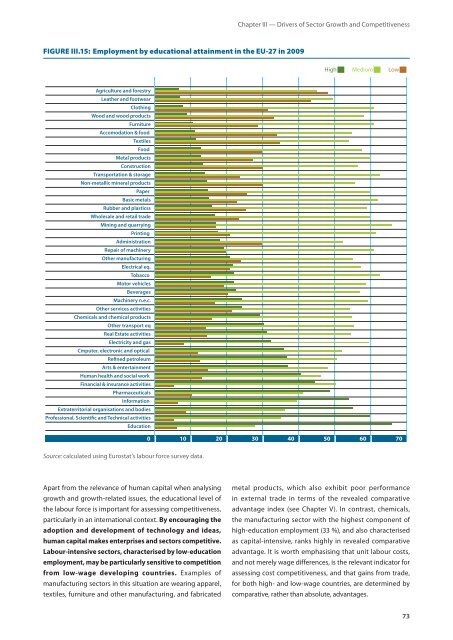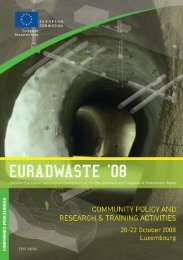EU industrial structure - EU Bookshop - Europa
EU industrial structure - EU Bookshop - Europa
EU industrial structure - EU Bookshop - Europa
You also want an ePaper? Increase the reach of your titles
YUMPU automatically turns print PDFs into web optimized ePapers that Google loves.
FIgURE III.15: Employment by educational attainment in the <strong>EU</strong>-27 in 2009<br />
Agriculture and forestry<br />
Leather and footwear<br />
Clothing<br />
Wood and wood products<br />
Furniture<br />
Accomodation & food<br />
Textiles<br />
Food<br />
Metal products<br />
Construction<br />
Transportation & storage<br />
Non-metallic mineral products<br />
Paper<br />
Basic metals<br />
Rubber and plasticss<br />
Wholesale and retail trade<br />
Mining and quarrying<br />
Printing<br />
Administration<br />
Repair of machinery<br />
Other manufacturing<br />
Electrical eq.<br />
Tobacco<br />
Motor vehicles<br />
Beverages<br />
Machinery n.e.c.<br />
Other services activities<br />
Chemicals and chemical products<br />
Other transport eq<br />
Real Estate activities<br />
Electricity and gas<br />
Cmputer, electronic and optical<br />
Rened petroleum<br />
Arts & entertainment<br />
Human health and social work<br />
Financial & insurance activities<br />
Pharmaceuticals<br />
Information<br />
Extraterritorial organisations and bodies<br />
Professional, Scientic and Technical activities<br />
Education<br />
Source: calculated using Eurostat’s labour force survey data.<br />
Apart from the relevance of human capital when analysing<br />
growth and growth‑related issues, the educational level of<br />
the labour force is important for assessing competitiveness,<br />
particularly in an international context. By encouraging the<br />
adoption and development of technology and ideas,<br />
human capital makes enterprises and sectors competitive<br />
labour‑intensive sectors, characterised by low‑education<br />
employment, may be particularly sensitive to competition<br />
from low‑wage developing countries Examples of<br />
manufacturing sectors in this situation are wearing apparel,<br />
textiles, furniture and other manufacturing, and fabricated<br />
Chapter III — Drivers of Sector Growth and Competitiveness<br />
High Medium Low<br />
0 10 20 30 40 50 60 70<br />
metal products, which also exhibit poor performance<br />
in external trade in terms of the revealed comparative<br />
advantage index (see Chapter V). In contrast, chemicals,<br />
the manufacturing sector with the highest component of<br />
high‑education employment (33 %), and also characterised<br />
as capital‑intensive, ranks highly in revealed comparative<br />
advantage. It is worth emphasising that unit labour costs,<br />
and not merely wage differences, is the relevant indicator for<br />
assessing cost competitiveness, and that gains from trade,<br />
for both high‑ and low‑wage countries, are determined by<br />
comparative, rather than absolute, advantages.<br />
73
















